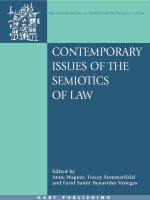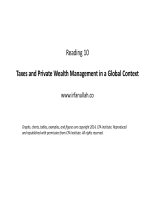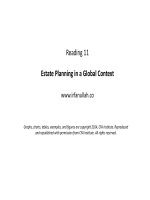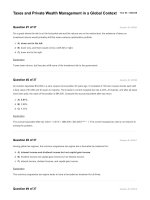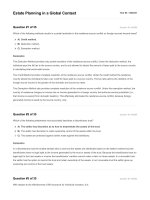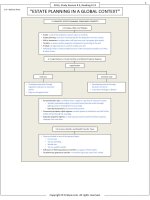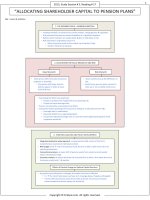FinQuiz smart summary estate planning in a global context
Bạn đang xem bản rút gọn của tài liệu. Xem và tải ngay bản đầy đủ của tài liệu tại đây (562.78 KB, 6 trang )
1
2013, Study Session # 4, Reading # 12
B.S = Balance Sheet
“ESTATE PLANNING IN A GLOBAL CONTEXT”
2. DOMESTIC ESTATE PLANNING: SOME BASIC CONCEPTS
2.1 Estates, Wills, and Probate
Estate ⇒ all of the property a person owns or controls.
Estate planning ⇒ process of preparing for the disposition of one’s estate.
Will or testament ⇒ rights other will have over one’s property after death.
Testator ⇒ person whose property is disposed of according to the will.
Probate ⇒ legal process to confirm validity of a will.
Individuals wish to avoid probate because of the associated sizeable court fees
& other issues.
2.2 Legal Systems, Forced Heirship, and Marital Property Regimes
Legal System
Civil Law
Common Law
Developed primarily through
legislative statutes or executive
action.
May not recognize trust.
Developed primarily through
decisions of courts.
Trace their heritage to Britain.
Forced heirship rules ⇒ children have a right to a portion of a parent’s estate.
Wealthy individuals might try to avoid forced heirship rules (through
gifting assets or moving them into a trust).
Claw back provisions to prevent this practice.
Community property rights regimes ⇒ each spouse is entitled to one-half of the
estate earned during the marriage.
Separate property regimes ⇒ each spouse owns & controls his/her property,
separate from the other.
2.3 Income, Wealth, and Wealth Transfer Taxes
Taxes are levied in one of four general ways:
Income tax.
Tax on spending.
Wealth tax.
Tax on wealth transfer.
Gift taxes or lifetime gratuitous transfers ⇒ apply to lifetime gifts.
Testamentary gratuitous transfer ⇒ transferring assets upon one’s death.
Copyright © FinQuiz.com. All rights reserved.
2013, Study Session # 4, Reading # 12
3. CORE CAPITAL AND EXCESS CAPITAL
Life B.S ⇒ comprehensive accounting of an investor’s explicit & implied assets &
liabilities.
Implied assets ⇒ PV of one’s employment capital & expected pension benefits.
Implied liabilities ⇒capitalized value of the investor’s desired spending goals.
Core capital ⇒ amount of capital to fund spending, to maintain a give lifestyle,
fund goals & adequate reserves for unexpected commitments.
Excess capital ⇒ capital that can be transferred to others without jeopardizing
the investor’s lifestyle.
3.1 Estimating Core Capital with Mortality Tables
Core capital can be estimated in the following ways:
Forecast nominal (real) spending needs & discount these using
nominal (real) discount rates.
Spending needs can be forecasted by multiplying each CF with survival
probability.
ߩሺݏ݈ܽݒ݅ݒݎݑݏሻ = ߩሺℎݏ݁ݒ݅ݒݎݑݏܾ݀݊ܽݏݑሻ + ߩሺݏ݁ݒ݅ݒݎݑݏ݂݁݅ݓሻ −
ߩሺℎݏ݁ݒ݅ݒݎݑݏܾ݀݊ܽݏݑሻ × ߩ()ݏ݁ݒ݅ݒݎݑݏ݂݁݅ݓ.
PV of the spending needs is equal to:
ே
ܸܲሺ݀݁݁݊݃݊݅݀݊݁ݏሻ =
ୀଵ
ߩ൫݈ܽݒ݅ݒݎݑݏ ൯ × ܵ݃݊݅݀݊݁
ሺ1 + ݎሻ
Sum of each year’s PV of expected spending represent’s the investor’s
core capital.
3.1.1 Safety Reserve
PV of spending needs underestimates the true core capital needs
(no guarantee that capital markets will produce return> RF).
Solution ⇒ incorporates a safety reserve.
Size of reserve can be based on a subjective assessment of
circumstances.
3.2 Estimating Core Capital with Monte Carlo Analysis
Estimate the size of a portfolio needed to generate sufficient
withdrawals to meet expanses (inflation adjusted).
Provides a range of possible outcomes & hence captures the risk
more appropriately.
Ruin probability of depleting one’s financial assets before death.
Return improves sustainability & requires core capital to
generate same level of spending.
Copyright © FinQuiz.com. All rights reserved.
2
3
2013, Study Session # 4, Reading # 12
4. TRANSFERRING EXCESS CAPITAL
4.1 Lifetime Gifts and Testamentary Bequests
4.1.1 Tax-Free Gift
Tax reliefs may apply to gifts from donors.
Gifts can escape transfer tax by falling below periodic or life time allowances.
Appreciated assets can effectively transfer if subject to exclusions or tax reliefs.
Relative after-tax value of a tax-free gif:
்ܴܸ௫ிீ௧ =
ீܸܨ௧
ൣ1 + ݎ ൫1 − ݐ ൯൧
=
ሾ1 + ݎ ሺ1 − ݐ ሻሿ ሺ1 − ܶ ሻ
ܸܨ௨௦௧
where
ܶ = estate tax if asset is bequeathed.
ݎ &ݎ = pretax return to the gift recipient & the estate making the gift.
ܶ &ܶ = effective tax rates on investment returns (both recipient & estate making the
gift).
n = time until the donor’s death.
If pretax return & effective tax rates are equal, the relative value reduces to
ଵ
ଵି்
4.1.2 Taxable Gifts
Value can be added even when a lifetime gift is taxable.
After-tax future value of the gift:
ீܸܨ௧
ൣ1 + ݎ ൫1 − ݐ ൯൧ ൫1 − ܶ ൯
=
ܸܨ௨௦௧ ሾ1 + ݎ ሺ1 − ݐ ሻሿ ሺ1 − ܶ ሻ
Assumes that gift tax is paid by the recipient rather than the donor.
If after tax returns gift = return of assets to be bequeathed the value of a taxable gift
்ܴܸ௫ீ௧ =
reduced to
൫ଵି் ൯
ሺଵି் ሻ
Another strategy ⇒ gift asset with
E(R) to the 2nd generation.
4.1.3 Location of the Gift Tax Liability
If the tax liability is imposed on the donor’s taxable estate, the size of
the estate & hence the ultimate estate tax.
Relative after-tax value of the gift when the donor pays gift tax:
்ܴܸ௫ீ௧ =
ீܸܨ௧
ൣ1 + ݎ ൫1 − ݐ ൯൧ ൫1 − ܶ + ܶ ܶ ൯
=
ሾ1 + ݎ ሺ1 − ܶ ሻሿ ሺ1 − ܶ ሻ
ܸܨ௨௦௧
4.2 Generation Skipping
Transferring assets directly to the third generation or beyond may
reduce transfer taxes (avoid layer of double taxation).
ܴ݈݁ܽ݁ݑ݈ܽݒ݁ݒ݅ݐ௧ௌ =
ଵ
ଵି்భ
where ܶଵis tax rate on 1st
generation
Some jurisdictions discourage generation skipping transfer tax.
4.3 Spousal Exemptions
Allow decedents to make bequests & gifts to their spouses without
transfer tax liability.
It is advisable to transfer the exclusion amount to someone other than
the spouse ( the taxable value of the surviving spouse’s estate).
Copyright © FinQuiz.com. All rights reserved.
4
2013, Study Session # 4, Reading # 12
4.4 Valuation Discounts
Taxes might also be mitigated by transferring assets
that qualify for valuation discounts.
Valuation discounts can be:
Illiquidity discount.
Discount for lack of control.
4.5 Deemed Dispositions
Some counties treat bequests as deemed
disposition (as if the property were sold).
Tax is levied on the value of unrecognized gains.
4.6 Charitable Gratuitous Transfers
Two forms of tax relief:
Most donations are not subject to a gift transfer tax.
Most jurisdictions permit income tax deductions.
Non-profit making organizations may also be exempt from taxation.
Relative after-tax future value:
ܴܸ௧ீ௧ =
ܸܨ௧ீ௧
൫1 + ݎ ൯ + ܶ ሾ1 + ݎ ሺ1 − ݐ ሻሿ ሺ1 − ܶ ሻ
=
ሾ1 + ݎ ሺ1 − ݐ ሻሿ ሺ1 − ܶ ሻ
ܸܨ௨௦௧
5. ESTATE PLANNING TOOLS
5.1 Trusts
An arrangement created by a settlor or granter who transfer asset to a trustee.
Trust document ⇒ document containing terms of the trust relationship.
Trusts can be used to reduce taxes, to protect assets & to control over assets even after transfer.
Categories of Trust
Revocable Trust
Settlor retain the rights &
responsible for tax payment.
Creditor can claim trust
assets.
Irrevocable Trust
Fixed Trust
Settlor has no ability to
revoke the trust relationship.
Trust assets are protected
against creditors’ claims.
Trustee pays tax.
Distributions to beneficiaries
are prescribed in the trust
document (amount & time).
5.2 Foundations
Mostly act similar to trusts:
Allow settlor’s wishes to follow after settlor’s death.
Asset protection.
Tax minimization.
Copyright © FinQuiz.com. All rights reserved.
Discretionary Trust
Trustee determines whether
& how much to distribute.
2013, Study Session # 4, Reading # 12
5.3 Life Insurance
Policy holder transfer premium to an insurer who has a contractual
obligation to pay death benefits to the beneficiary.
Death benefits & premium paid are tax exempt in most jurisdictions.
Also serve as a liquidity planning technique & offer asset protection.
Insurance policy can assign a discretionary trust (if beneficiaries are
unable to manage the assets themselves).
5.4 Companies and Controlled Foreign Corporations
Controlled foreign corporation (CFC) ⇒ a company located outside
a tax payer’s home country (tax payer has a controlling interest).
Benefits of placing income generating assets in CFC include:
Tax Deferrals.
Tax avoidance.
6. CROSS-BORDER ESTATE PLANNING
6.2Tax System
Source jurisdiction or territorial tax system ⇒ country
that taxes income as a source within its borders.
Residence jurisdiction ⇒ taxes based on residency.
Tax System
6.2.1 Taxation of Income
Individuals subject to residence
jurisdiction are taxed on their
worldwide income.
Residency tests may consider
subjective as well as objective
standards.
6.2.2 Taxation of Wealth and Wealth Transfers
Source principle ⇒ tax assets that are
economically sourced or transferred within a
particular country.
Residence principle ⇒ imposes transfer tax
on all assets transferred by donor.
6.2.3 Exit Taxation
Tax on unrealized gains accrued on assets leaving the jurisdiction.
May also include an income tax on income earned over a fixed
period after expatriation called “shadow period”.
6.3 Double Taxation
Residence-residence conflict ⇒ two countries may claim
residence of the same individual.
Source-source conflict ⇒ two counties may claim source
jurisdiction of the same asset.
Residence –source conflict is most common source of
double taxation.
Copyright © FinQuiz.com. All rights reserved.
5
2013, Study Session # 4, Reading # 12
6.3.1 Foreign Tax Credit Provisions
Residence-source conflict can be resolved using one or more of the following methods:
Credit method ⇒ ܶெ = ݔܽܯሾܶܽݔ௦ௗ , ܶܽݔ௦௨ ሿ
Exemption method ⇒ ܶாெ = ܶܽݔ௦௨
Deduction method ⇒ܶெ = ܶܽݔ௦ௗ + ܶܽݔ௦௨ − ܶܽݔ௦ௗ ܶܽݔ௦௨
6.3.2 Double Taxation Treaties
Intended to facilitate international trade &
investment by eliminating double taxation.
DTTs typically don’t resolve source-source conflict.
6.4 Transparency and Offshore Banking
Tax avoidance ⇒ legal tax minimizing or tax avoidance
strategies.
Tax evasion ⇒ illegal means to circumvent tax obligation.
Copyright © FinQuiz.com. All rights reserved.
6



